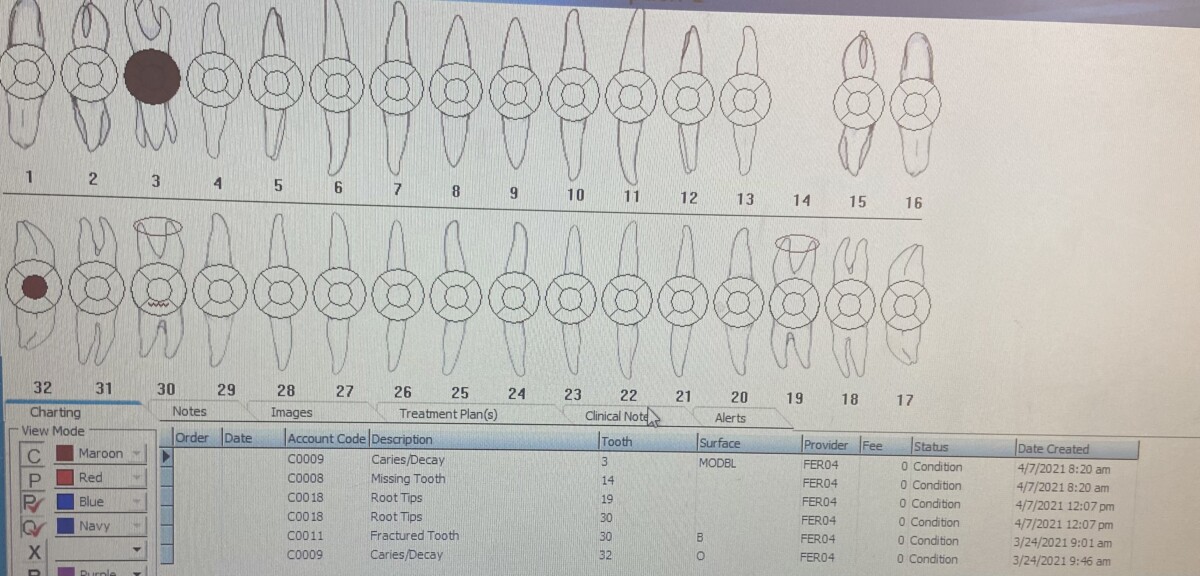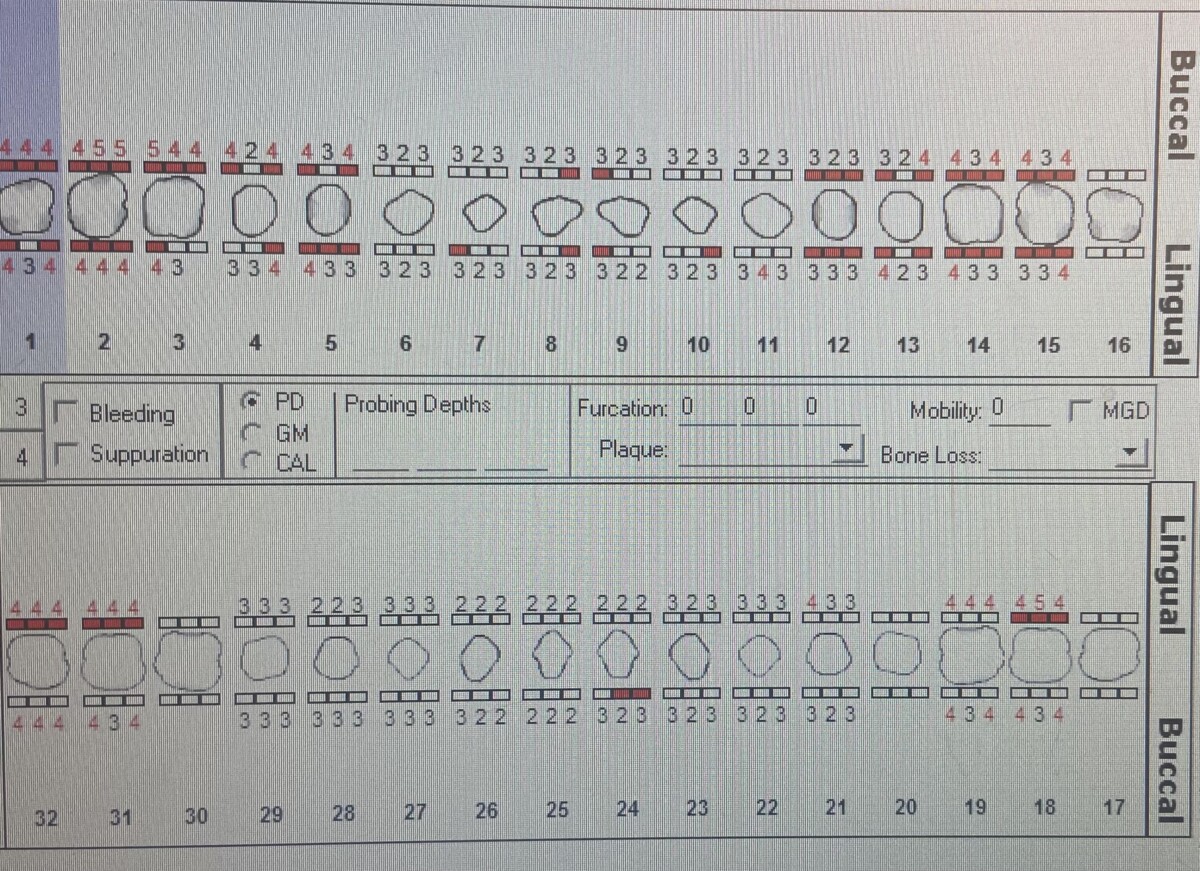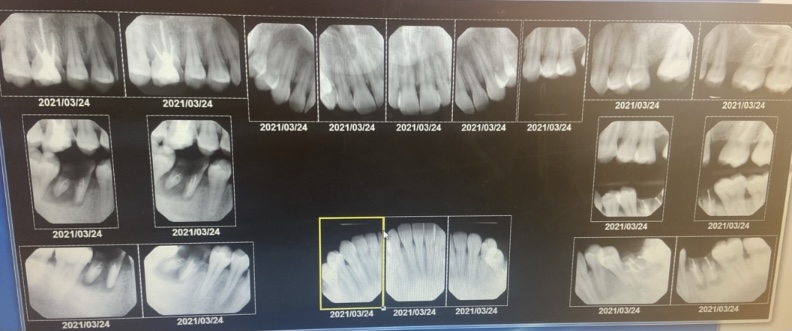Case Study 1 : 11 Years without dental care
Demographics:
A.R, Female ,27 year old Hispanic, Heavy/ Stage 2 grade B.
Assessment:
Patients significant findings in medical history , Patient is sensitive to cold and hot air in all surfaces. Takes Excedrin only when experiencing migraines. Patient last dental exam was in 2010 and had only done a dental cleaning.
-
-
- Patient is ASA 1
- Vital signs- Blood Pressure :112/80 with Pulse:72
- Non-social drinker, no pre-medication needed, and, no systemic conditions present.
-
Oral Pathology
EO: Scar on right side of the cheek 4mm by 4mm red, flat and crust form.
IO: Bilateral linea alba, slightly coated tongue , mandibular tori, Tonsils slightly red, and Hyperkeratinized palate.
Dentition
Bilateral Class 1 Occlusion.
- 3mm overjet
- 25% overbite
- PD 5mm/limited probing due to calculus .
- Patient is missing tooth number #14
- Patient has active caries lesions on #3 MODBL and #32 O
- Patient has root tips present on teeth #19 and #30
- Patient has fractured tooth on #30B
Periodontal
Case Type Stage 2/Grade B
- Patient has generalized 2-3mm probing depths with localized 4-5mm on premolar and molar regions.
- Generalized severe bleeding upon probing on all surfaces.
Gingival Assessment: Generalized mild to severe inflammation, pigmentation, papilla is bulbous, red and bleeding. Noted nicotine stomatitis .
Oral Hygiene
Patient initial plaque score was 1.0 poor. This patient was a heavy case value with generalized supra and sub gingival calculus. Calculus was found on all surfaces but more prominent on mandibular anteriors lingual surfaces on teeth #22-27.
Planed OHI: On the patients first visit in the clinic the examination with the red disclosing agent was used to show where to focus when bushing. Patient first advised us that she brushes twice a day. Upon the findings with the plaque score this patient was not using the proper technique when brushing or flossing since most of the plaque was in both facial and interproximal surfaces. On the the first visit we focused only on Tooth brushing technique and I introduced her the Modified Bass tooth brushing technique using the manual toothbrush. I also educated the patient the importance of oral hygiene and care of her beautiful teeth, we went over what is plaque and calculus .
Second visit plaque index was 0.7 fair with most of the plaque on the interproximal surfaces. The patient first stated that she has implemented the new toothbrush method twice a day and thinks she will use this method from now on. After showing her where her plaque was I congratulated her that her toothbrushing is very effective since there wasn’t as much plaque on facial surfaces as the first visit now it was more interproximal. I then showed her how to floss by using the right middle finger to hold floss, and excess onto left middle finger of left hand, slide in a short sawing motion, make c-shape against the tooth and use up or down movement. We practiced this together till she felt confident using the floss.
I emphasized how these new oral hygiene methods will help reduce gingival inflammation and bleeding when she brushes.
Radiographs
Patient was exposed for an FMS to check those root tips , active caries lesions and to confirm periodontal conditions. Patient was given Referal to DDS for active caries , fractured tooth and root tips.
Radiographic statement:Fractured all first molars,calculus on all surfaces. Bone loss noted on all first molars 15% bone loss.
Treatment Management
Initial visit
I reviewed patient’s medical history and IO/EO examination were within normal limits. Completion of probing and calculus detection were done. FMS was taken to stage and grade.Started scaling quadrant four.
Visit 2
Reviewed her medical history and intraoral examination again- within normal limits.
Plaque score 1.0 poor, introduced effective toothbrush method the Modified Bass method , Scale quadrant 4 and 1 with hand instruments and applied 20% Benzocaine tropical to finish scaling quadrant 4. While working on this patient is was a bit scary to work where there was only root tips since she was very sensitive around those areas.
Visit 3
Plaque score 0.7 fair , Introduced second aid of flossing, re-scales on quadrant 4 and scaled quadrant 2. Less bleeding was noted after this visit compared to the first visit.
Visit 4
Plaque score was 0.6 fair, reviewed both Modified Bass TB and flossing. Finished with re-scales and quadrant 3, engine polished and applied 5% fluoride varnish treatment.
Based on the plaque scores, I would not change any part of my treatment plan or the patient’s education plan. Patient’s plaque score was taken three times throughout the treatment plan the first it was poor and gradually got better to 0.6/fair with less bleeding and inflammation.
I showed the patient the difference in scores and complimented her for her oral hygiene practice. I told her to continue following the instructions provided for tooth brushing and flossing.
No medical, social, psychological factors were present that impacted treatment.
Evaluation
Initially the patient came in just for a dental cleaning and did not have any knowledge on what was happing in the oral cavity. However after showing her periodontal charting and FMS she had more interest in taking care of her teeth. I showed her where the plaque retention in her mouth was located by using the disclosing solution. Patient became more inclined and interested in my demonstration and instructions and has applied it.
Reflection
I believe I accomplished everything I had in my treatment plan , specially my patient’s plaque score was reduced. My patient was motivated by the methods I taught and demonstrated. Introducing the modified bass tooth-brushing and flossing method were important for the patient’s education. Overall, I am very satisfied because I was able to motivate my patient to conduct health oral hygiene practices. And most importantly I saw a bright smile as she left.





